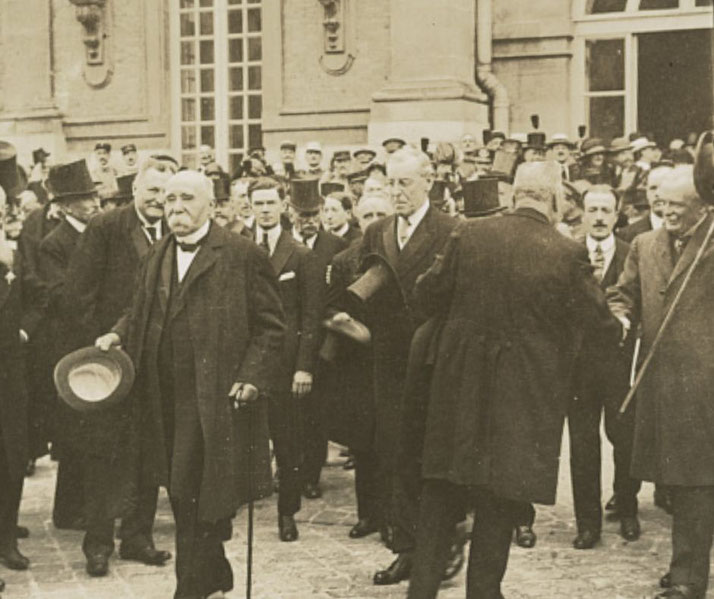How the Treaty of Versailles punished Germany for the First World War

Military operations in World War One concluded at 11 am on November 11, 1918, but the war's official end did not come until the Treaty of Versailles was signed over six months later.
This treaty would be considered the official document that would ultimately decide who was to blame for the war, and what their punishment would be.
This treaty was named after the location where it was created: the palace of Versailles, just outside of Paris in France.
However, the process of creating this treaty would take months, with representatives from countries all around the world holding a range of discussions in order to ensure that everyone could share their needs and wants.
Why was Germany the target of the blame?
The four main global leaders who led the discussions and negotiations were Lloyd George of Britain, Orlando of Italy, Clemenceau of France, and Woodrow Wilson of the United States.
These world leaders represented the largest of the victorious Allied powers from the war.
In 1919, out of the two defeated countries, Germany and Austria-Hungary, only one was in a position to be the target of the blame: Germany.
This was because the Austro-Hungarian Empire had already disintegrated by the end of World War I, breaking up into several independent nations such as Austria, Hungary, Czechoslovakia, and Yugoslavia.
With the empire no longer existing as a political entity, it was almost impossible to hold it accountable in the same way as Germany.
Moreover, Germany was seen as the main aggressor in the war, especially due to its violation of Belgian neutrality, which had brought the United Kingdom into the conflict.
As a result, at the treaty discussions, the focus was on how Germany would be compelled to pay for the devastation caused by World War One.
To facilitate the decision-making process, President Wilson brought a 14-point strategy with him that he felt would bring Europe's peace if the treaty was based upon it.
President Wilson's 14-point plan
- There should be no secret treaties between powers, according to open diplomacy.
- Freedom of Movement - The seas should be safe for navigation in both peace and conflict.
- Free Commerce — Barriers to cross-border trade, such as customs duties, should be eliminated.
- Disarmament on a Global Scale - All countries should decrease their military forces to the smallest possible size.
- Colonies - Colonies owned by European powers should have a vote in their own destiny.
- Russia - Russians should be free to run their government as they see fit, and that government should be recognised, supported, and welcomed.
- Belgium — Belgium borders should be restored to its pre-war state.
- France — Alsace-Lorraine, as well as any areas taken away during the war, should be returned.
- It is necessary to redraw the Italian border according to nationality.
- National Self-Determination — Wherever feasible, national groupings in Europe should be allowed autonomy.
- Romania, Montenegro, and Serbia - Occupying troops in these three countries should be removed, and Serbia should have a seaport.
- Turkey - The Turkish people should have a say in their own destiny.
- Poland – Poland should become a self-contained country with a seaport.
- League of Nations - To ensure future world peace, an assembly of all nations should be convened.
Negotiating the treaty
On the basis of these fourteen criteria, Germany expected a workable treaty.
However, discussions between the "big four" did not go easily. Each country had their own expectations of what the final treaty would say, and these were often in conflict with what other countries wanted.
For example, Wilson thought that enacting his fourteen ideas was the best way to ensure perpetual peace.
The French, on the other hand, wanted the defeated nations to be punished harshly and considered Wilson's approach too lenient.
Although Lloyd George supported Wilson in private, despite his concerns about Communism, the British public, like Clemenceau, wanted Germany punished harshly.
As a result, Lloyd George was well aware that siding with Wilson would result in him losing the next British election.
So, after much deliberation, an agreement was ultimately achieved. On June 28, 1919, the Germans were called to Versailles to sign the Treaty of Versailles.
The final terms
The final version of the Treaty of Versailles contained 440 clauses: the first 26 clauses focused on the creation of the League of Nations, while the remaining 414 detailed how Germany was to be punished.
Here is a brief summary of the main details:
- The League of Nations was to be set up.
- A 'War Guilt clause' forced Germany to accept the blame for starting WWI.
- Germany was to pay the cost for the damage caused during the war. The fee was set at £6,600 million, called 'reparations'.
- Germany's army was to be reduced to 100,000 men.
- Germany was not allowed to own military tanks.
- Germany's navy was only allowed six ships but weren't allowed submarines.
- Germany was not allowed to own an air force.
- The Rhineland region was to be kept free of German control.
- Germany was not allowed to join politically with Austria.
- The region of Alsace-Lorraine was handed back to France.
- Land was taken from Germany to create regions of Czechoslovakia and Poland.

Other important treaties after WWI
While the Treaty of Versailles was the most important document created to resolve the outcome of the war, it was not the only one.
There were a number of other treaties that reshaped Europe following the war.
Here are a few significant ones:
The Treaty of Saint-Germain-en-Laye, signed on September 10, 1919, dealt with the dissolution of the Austro-Hungarian Empire.
It imposed significant territorial and military restrictions on Austria by taking land from Austria and giving it to Italy, Czechoslovakia and Serbia.
Austria's army was limited to 30,000 men and the country was not allowed to merge with Germany. Also, Austria had to pay limited reparations.
At the Treaty of Trianon on the 4th of June 1920, Hungary lost land to Austria, Czechoslovakia, Romania and Serbia.
At the Treaty of Neuilly on 27th November 1919, Bulgarian land was given to Greece, Romania, and the newly formed Kingdom of Serbs, Croats, and Slovenes (which would later become Yugoslavia).
In addition, Bulgaria was also ordered to pay 90 million pounds in reparations, and its army was reduced.
Finally, in the Treaty of Sèvres on the 20th of August 1920, the Ottoman Empire (later Turkey) had to cede land to Greece and relinquish all of its overseas territories.
What do you need help with?
Download ready-to-use digital learning resources
Copyright © History Skills 2014-2025.
Contact via email
With the exception of links to external sites, some historical sources and extracts from specific publications, all content on this website is copyrighted by History Skills. This content may not be copied, republished or redistributed without written permission from the website creator. Please use the Contact page to obtain relevant permission.





